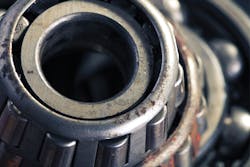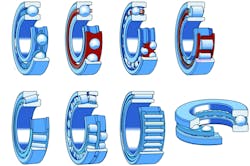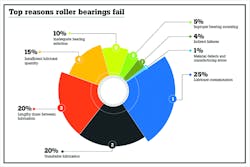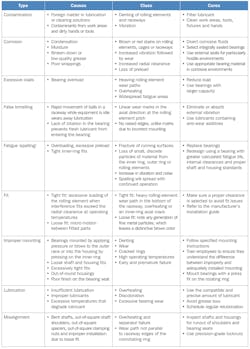Historians believe varying forms of rolling bearing elements have existed for ages and were likely used to assist workers in constructing the Egyptian pyramids. One of the strongest examples of early usage materialized in 1929. Roman ships from the first century were retrieved from the bottom of Italy’s Lake Nemi.1 Scholars examined a round platform embedded with lead ball bearings and believe the mechanism was designed to rotate a life-sized statue on one of the ships.
Today, roller bearing mechanisms are used in thousands of industrial, automotive, marine and aerospace applications. Whether cylindrical, spherical, gear, tapered or needle, roller bearings work to reduce rotational friction to support radial and axial loads (see Figure 1).
Lubrication is critical to roller bearing life
Roller bearing failure has the potential to shut down running equipment and possibly entire plant operations. Roller bearings require lubrication to reduce the metal-to-metal friction between the rolling and sliding contact areas. Letting lubrication-related tasks lapse can ultimately mean catastrophic equipment failure.
Lubricating helps disperse heat from the bearing, remove wear particles and contaminants from the rolling contact areas, protect against corrosion and increase bearing seal bonds.
Four of the top reasons roller bearings fail results from poor lubrication or lack thereof.
Lubricant contamination
As shown in Figure 2, the prime reason roller bearings fail to reach life expectancy is due to lubricant contamination from particles. To the naked eye, a lubricant sample might look clean, but in fact, contains tiny wear-causing contaminants, including dirt, dust, sand, metal shards and other elements. Pollutants can damage bearings, thus wearing them prematurely. Furthermore, once the roller bearing sustains damage, the condition is usually irreversible, and no amount of maintenance, except replacement, can restore the bearing to its original state.
Figure 2. Top reasons roller bearings fail. Courtesy of Fluke CorporationParticles can be introduced in countless ways, including during lubricant production. The amount of debris in newly produced oil or grease can differ by as much as a factor of 1,000. Large quantities can contain even higher amounts. Particles can also be introduced during maintenance or replacement, or because of wear, fatigue, aging and imbalance caused by leaks, worn seals and other breaches.
Four principal ways to avoid particle contamination include:
- Purchase lubricants from a reputable company. Information about the product should be readily available including specifications. Depending on the application, evidence should show that standards, such as IEC, ASTM, ISO or DIN, are up to date.
- Store lubricants indoors and keep them away from heat and other possible sources of contamination. Lay drums horizontally. Select lubricant usage based on the purchase date, i.e., oldest to newest.
- Test equipment for imbalance, misalignment and other conditions. Use vibration analysis, thermography and other proactive maintenance methods to prevent wear.
- Ensure lubricant is clean. When replacing grease or oil, equipment should also be clean.
Indicators of emerging bearing failure
Regular preventive maintenance (PM) and predictive maintenance (PdM) strategies can help keep bearings operating. Although designed to last, roller bearings cannot rotate forever. Sooner or later, they experience material fatigue.
Evidence of bearing issues appears in many forms, including:
- Grooving: Contaminants wedged in soft cage material can incise grooves in rolling elements. Generates improper rolling contact geometry. Reduces bearing service life.
- Noise: Bearing damage can be distinguished by unusual yet characteristic noise using sound detection instruments during operation.
- Peeling: Caused by hairline cracks. Condition consists of small areas of flaking due to insufficient lubrication or infiltration of foreign matter.
- Spalling: Pitting or flaking away of bearing material. Primarily occurs on races and rolling elements. Always accompanied by an increase in vibration. Condition will continue to spread with ongoing operation.
- Overheating: Ring discoloration of rolling elements and cages from gold to blue. Temperatures over 400°F can anneal ring and rolling element metals, reduce bearing capacity and cause early failure. High temperatures can also degrade or destroy lubricant.
- Pitting: Small areas of flaking or peeling caused by hairline cracks. Condition may be caused by foreign matter infiltration or insufficient lubrication.
- Vibration: Bearing irregularities can be analyzed by measuring the vibrations of an operating machine using a frequency spectrum analyzer to calculate the magnitude of vibration and frequency distribution. Test results help determine the likely cause of the bearing abnormality.
Premature roller bearing failure
Learning to troubleshoot bearing problems is a crucial part of any maintenance program. As many as 13% of industrial motor failures happen because of bearing failures. Moreover, 60% of equipment breakdowns involve bearing wear.
Most defects result from a combination of failure modes, and each failure is usually due to a mixture of causes.
Table 1. Causes, clues and cures for premature roller bearing failureVibration: A chief precursor to bearing failure
Usually, before bearings fail, the problem appears in the form of vibration. For example, roller bearings will cause vibration each time they pass over a damaged or pitted roller bearing race. Without being harmful or invasive, vibration analysis provides the most detail about what is happening inside machinery by detecting minuscule changes in acceleration, direction or velocity that may indicate bearing wear, installation error or other mechanical problems.
Wireless condition monitoring vibration sensors installed on a bearing housing can provide maintenance teams with actionable data. Technologically advanced tools can help further ferret out more complex issues that might show up in the overall vibration analysis. It can then be used to decide whether additional analysis is required and if relubrication, repairs or replacements are needed.
Infrared (IR) thermography can also be used for oil analysis to discover if wear particles or other contamination-causing issues are present in the roller bearing. Thermal imaging sensors can be set in place to monitor equipment condition safely. Measurements are taken from a distance and uploaded to the cloud, where technicians can view them on a smart device, such as a mobile phone, tablet or computer. The data can then trend temperature changes over time and help determine if bearings are operating optimally or headed for a breakdown.
Boost roller bearing life using PM and PdM strategies
Fortunately, by carrying out preventive maintenance tasks, roller bearings have a better chance of reaching their full potential. When predictive maintenance tools, such as vibration sensors, are integrated with computer maintenance management software (CMMS), maintenance teams can set acceptable boundaries for equipment operation, import and view continuous readings and graph results. Additionally, the system can be configured to automatically trigger an email or generate a work order — should equipment exceed parameters. With cloud technology, maintenance and reliability (M&R) teams can view data in real time from anywhere, any time.
Premature roller bearing failure can affect business, the environment and personnel — should the bearing cause an explosion. Even the most comprehensive maintenance program can result in undetected faults, leading to unexpected failures. However, through proper care and with the help of proactive maintenance strategies, M&R teams can further ensure roller bearing reliability.
References
- Britannica, T. E. (2011, June 09). Lake Nemi. Retrieved from https://www.britannica.com/place/Lake-Nemi.
John Bernet, a mechanical application and product specialist at Fluke Corporation, works with customers from all industries to help them successfully implement their reliability programs. He is a former U.S. Navy nuclear power plant electrician and has more than 30 years of experience in the maintenance and operation of commercial machinery. Bernet holds a Category II Vibration Analyst certification and is a Certified Maintenance Reliability Professional (CMRP).






